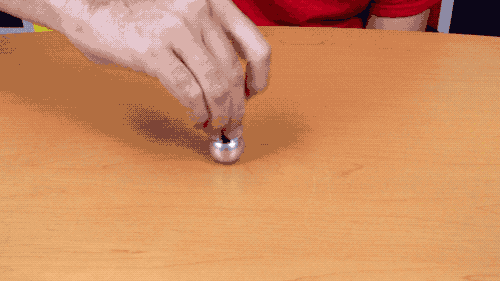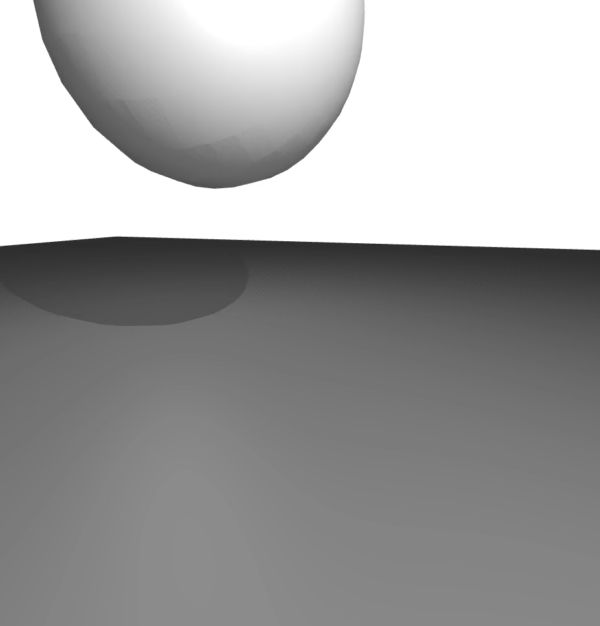Detailed Mechanism Definition
Here, we describe in detail how to define your own dynamical system of Mechanism. After it has been defined, it will be extremely easy to simulate it, control it, perform trajectory optimization on it, or even policy optimization.
We're going to build a tippe top:


Build Mechanism
We will take a look at the definition of get_tippetop in DojoEnvironments. This function return a Mechanism and takes as input a variety of parameters like the simulation time step, gravity etc. You can add as many parameters you want. This example is typical of what you will find in Dojo.
To build the mechanism corresponding to the tippe top, we decompose it into two spherical bodies. Each body has its own spherical contact constraint with the floor. The joint between the two bodies is a Fixed joint and the joint between the main body and the Origin of the frame is a Floating joint.
function get_tippetop(;
timestep=0.01,
input_scaling=timestep,
gravity=-9.81,
mass=1,
radius=0.5,
scale=0.2,
color=RGBA(0.9, 0.9, 0.9, 1.0),
springs=0,
dampers=0,
limits=false,
joint_limits=Dict(),
keep_fixed_joints=false,
friction_coefficient=0.4,
contact=true,
contact_type=:nonlinear,
T=Float64)
# mechanism
origin = Origin{T}(name=:origin)
bodies = [
Sphere(radius, mass; name=:sphere1, color),
Sphere(radius*scale, mass*scale^3; name=:sphere2, color)
]
bodies[1].inertia = Diagonal([1.9, 2.1, 2])
joints = [
JointConstraint(Floating(origin, bodies[1]); name=:floating_joint),
JointConstraint(Fixed(bodies[1], bodies[2];
parent_vertex=[0,0,radius]), name = :fixed_joint)
]
mechanism = Mechanism(origin, bodies, joints;
timestep, gravity, input_scaling)
# springs and dampers
set_springs!(mechanism.joints, springs)
set_dampers!(mechanism.joints, dampers)
# joint limits
if limits
joints = set_limits(mechanism, joint_limits)
mechanism = Mechanism(mechanism.origin, mechanism.bodies, joints;
gravity, timestep, input_scaling)
end
# contacts
contacts = ContactConstraint{T}[]
if contact
n = length(bodies)
normals = fill(Z_AXIS,n)
friction_coefficients = fill(friction_coefficient,n)
contact_radii = [radius;radius*scale]
contacts = [contacts;contact_constraint(bodies, normals; friction_coefficients, contact_radii, contact_type)]
end
mechanism = Mechanism(mechanism.origin, mechanism.bodies, mechanism.joints, contacts;
gravity, timestep, input_scaling)
# zero configuration
initialize_tippetop!(mechanism)
# construction finished
return mechanism
endInitialize Mechanism
The second method that we need to look at is initialize_tippetop!. This function initialize the dynamical system to a certain state. This means that we set the position orientation, linear and angular velocity of each body in the mechanism.
function initialize_tippetop!(mechanism::Mechanism{T};
body_position=2*Z_AXIS*mechanism.bodies[1].shape.r, body_orientation=one(Quaternion),
body_linear_velocity=zeros(3), body_angular_velocity=[0.0, 0.1, 50.0]) where T
# zero state
zero_velocities!(mechanism)
zero_coordinates!(mechanism)
# set desired state value
floating_joint = mechanism.joints[1]
set_minimal_coordinates!(mechanism, floating_joint,
[body_position; Dojo.rotation_vector(body_orientation)])
set_minimal_velocities!(mechanism, floating_joint,
[body_linear_velocity; body_angular_velocity])
end